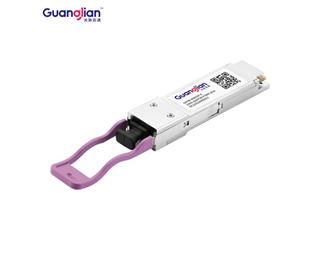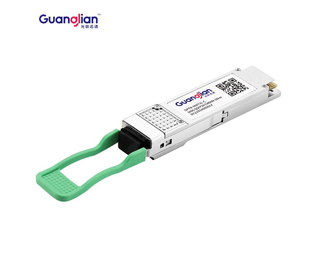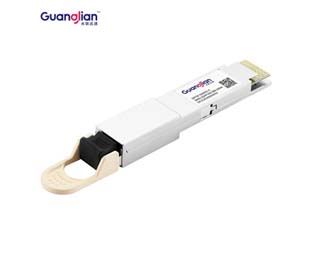Nowadays, the development of optical modules is unstoppable, among which 100G optical modules occupy most of the market share, such as 100G CFP, QSFP28, etc. So 100G CFP vs QSFP28, what are the differences, and how to choose? In this article, we will introduce CFP and QSFP28 and their specific applications in detail.
For the differences between 100G CFP and QSFP28, this article will introduce them from the aspects of the definition, power consumption, port density, cost, and application.
100G QSFP28 ER4 Optical Module
CFP is a multi-source agreement (MSA) used to define the form factor of an optical transceiver for high-speed digital signal transmission. The electrical connection of CFP uses 10 10 Gbit/s channels in each direction (RX, TX). Meanwhile, the fiber optic connection can support 10x 10 Gbit/s and 4x 25 Gbit/s variants of 100 Gbit/s. 100G CFP modules provide connectivity options for a wide range of service provider transport, data center networks, and enterprise core aggregation applications.
The QSFP28 transceiver module integrates four transmit channels and four receive channels. The "28" indicates that each channel can carry up to 28G data rates. qSFP28 can make 4x 25G branch connections or 1x 100G connections, depending on the transceiver used. For example, you can use a 100G QSFP28 to 4 SFP28 DAC cable for 4x 25G branched connections and an LC interface-based QSFP28 with single-mode fiber (or an MTP/MPO interface-based QSFP28 transceiver with a 12-cell MTP/MPO patch cable) for 1x 100G connections directly.
100GBASE-CFP2-LR4-10km Receiver Only Optical Transceiver Module
Power consumption plays an important role in transceiver hardware decisions, given budget, network configuration, and overall bandwidth capability. qSFP28 optical modules typically consume less than 3.5W, while other 100G optical modules consume 6W to 24W.
The QSFP28 is the smallest 100G transceiver on the market in terms of size. the CFP4 is only a quarter of the width of the first generation CFP. However, it is still about 66% larger than the QSFP28 in package form factor. This size difference indicates that the QSFP28 is more efficient than the CFP in terms of port utilization.
Given the power consumption and port density, it is less expensive to use QSFP28 in a system. In addition, QSFP28 is cheaper than CFP.
CFP is one of the recommended 100G optical modules, mainly used in metro networks and long-distance transmission (typically above 10km).
100GBASE-QSFP28-PSM4-500m/2km Optical Transceiver Module
There are many QSFP28 products on the market, which are divided into the following four main applications based on transmission distance.
QSFP28 DAC cables are ideally suited for short-distance connections within 5m. They can be supplied as complete cable assemblies in a cost-effective manner.
The QSFP28 AOC is best suited for 3-20m, and the QSFP28 SR4 transceiver with 12-cell MTP OM3/OM4 cable can support transmission distances of up to 100m.
For 100m to 2km, QSFP28 PSM4/CWDM4/CLR4 transceivers provide a cost-effective solution. They can support up to 500m of 12-cell MTP single mode fiber and 2km of duplex LC single-mode fiber, respectively.
For long-span 100GbE deployments, such as connections between two buildings (mostly up to 10km), the QSFP28-100G-LR4 with duplex LC Singlemode fiber is the preferred option as defined by IEEE. For longer distances (up to 40 km and 80 km), 100G QSFP28 ER4/ZR4 transceivers are better.
As for 100G CFP vs QSFP28, which one do you use for your network build? Actually, it depends on two main aspects: the type of ports in your hardware device and the application scenario. 100G QSFP28 seems to be the mainstream, mainly for shorter distances between switches (0-10 km), sometimes using QSFP28 ER4/ZR4 and single-mode fiber for longer distances (up to 40/80 km). . While 100G CFPs are also available for short distances, they are more common in metropolitan area networks (MANs) and long-haul WDM transport.
Guanglian's cloud data center optical transceivers solution, including 10G/25G/40G/100G/200G/400G, all our data center optical transceiver uses our mature and experienced high-speed COB manufacturing technology to provide our customers a cost-effective solution with highly reliable, excellent consistency on optical performances. Guanglian’s strong R&D department will continue to provide better solutions for the industry. If you want to know more information about the best optical transceiver, welcome to contact us today or request a quote.
100G CFP vs QSFP28: Which One to Choose?
Jun. 11, 2022What Makes the Best Optical Transceiver Module?
May. 27, 2022200G QSFP56 Optical Module Knowledge Full Explanation
Apr. 25, 2022
100G CFP vs QSFP28: Which One to Choose?
Jun. 11, 2022
What Makes the Best Optical Transceiver Module?
May. 27, 2022Copyright ©Guanglian Xuntong Technology Group Co., Ltd. All Rights Reserved | Sitemap
